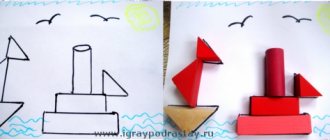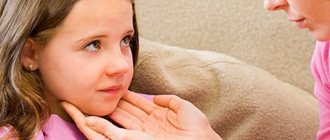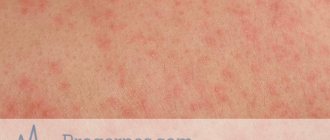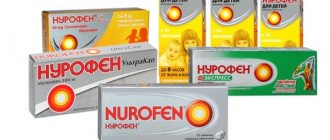Seven days ago
It all started with a common cold. My two-year-old daughter had a fever of 38 in the evening, she was sneezing incessantly, and had a severe runny nose. That is, all the symptoms of a viral infection are visible. As usual, in such cases, we begin treatment with antiviral drugs (Derinat, Anaferon for children), and at a temperature above 38.5 we give antipyretics. I usually “bring down” a high fever with paracetamol in a child’s dosage. But after three days the temperature did not drop; on the contrary, it “steadily” remained at 39 and above. All this time, the baby complained of pain in the stomach and gums, the daughter could not breathe at all - her nose was stuffy. As a result, we were given an accurate diagnosis only a week later, when we passed the necessary tests.
Why is it so difficult to diagnose mononucleosis?
First of all, infectious mononucleosis is very similar to a sore throat with the same symptoms of inflamed and enlarged tonsils and fever. In addition, the patient’s lymph nodes, liver and spleen enlarge, the composition of the blood changes, and difficulty breathing appears.
Many children suffer from infectious mononucleosis easily. 8 out of 10 children develop infectious mononucleosis between the ages of 4 and 15 years. In children under adolescence, mononucleosis is often not diagnosed because it occurs in the form of fever, accompanied by mild fatigue, and the illness is usually short-lived. A mild form of this disease can only be detected by a blood test, since in most cases the patient simply does not notice this disease and mistakes it for a manifestation of a viral infection. During adolescence or adulthood, mononucleosis can take the form of a long-term, debilitating illness.
The incubation period for mononucleosis can be long, sometimes reaching several weeks. This is why it is so difficult to connect cause and effect. Severe symptoms of infectious mononucleosis usually last for 2-4 weeks, followed by gradual recovery.
What is mononucleosis?
Mononucleosis (EBV) is an infectious disease that can be present in the human body for a long time and not manifest itself. This is a kind of virus (the exact definition is B-lymphotropic), which belongs to the herpes group (the fourth herpes virus) and is named after the discoverers of Epstein-Barr.
The disease itself is often called monocytic tonsillitis or benign lymphoblastosis. Its characteristic feature is a chronic, lifelong form without significant outbreaks. That is, a person is a carrier and can infect others through airborne droplets (the disease was once called the “ kissing disease ”), but he himself never suffers from an acute form of mononucleosis.
Unfortunately, the distribution statistics are not at all encouraging and in some places reaches 95-100% of victims. Moreover, about 50% of children are chronic spreaders (their parents may not even know about the disease). It is important that children under 15 years of age are primarily at risk.
Until they reach adulthood, this virus (like the herpes simplex virus) may not manifest itself at all and may not affect their health in any way. Only in some cases does the pathogen become active and show its symptoms. Then the little patient is diagnosed with infectious mononucleosis.
As for adults, there are fewer healthy ones - only 20% of the disease never manifests itself.
How does infection occur?
I kept wondering where my daughter “caught” the virus and could I have prevented this disease? But after reading the literature and information on websites, I came to the conclusion that it was impossible to avoid infection.
Infectious mononucleosis is caused by the Epstein-Barr virus.
The virus is transmitted through saliva during coughing, sneezing and kissing. The virus persists in the saliva of an infected person for 6 months or more after recovery.
However, not all people who have direct contact with an infected person become ill. The Epstein-Barr virus is characterized by low contagiousness; Direct contact with saliva is necessary for transmission of the virus to occur.
On one of the sites I found information that if one of the children in a kindergarten or school gets this disease, then this is not a reason for quarantine. In this case, you just need to do wet cleaning. But apparently, in our kindergarten, the children either licked the toys well, or important cleaning was not done so often. But, as it turned out, several people in our group suffered from sore throat and stomatitis. Three children were diagnosed with infectious mononucleosis.
How to treat infectious mononucleosis at home?
First of all, a sick child needs rest. If there is a high temperature, it needs to be brought down to normal. You need to talk with your child about the fact that his calm physical state now is extremely important for subsequent recovery. It is not always possible to persuade a child to lie down and be sick in a calm state. Some children with a hyperactive diagnosis, even in a sick state and with a decline in physical strength, cannot be inactive.
It is very important to introduce the procedure of rinsing the mouth and throat with hot (but not scalding!) water with salt dissolved in it. This procedure not only alleviates the condition, but also reduces the risk of developing the disease and prevents complications. Drinking plenty of fluids is included in the diet. Purified and boiled water helps the body fight infection. It is also necessary to take antipyretic drugs. Carefully read the trade names of antipyretics, their reviews, and be sure to consult your doctor.
Treatment of mononucleosis in children may have only minor problems: the reluctance of the child himself to do what the parent requires. No child has ever liked gargling and constant inactivity while lying in bed. The parents' task is either to come to an agreement or to force the fidget to rest physically. Try not to let your child move a lot, at least until his state of fatigue disappears. An enlarged spleen is at risk of rupture of the integumentary tissue, and any movement of the body is extremely undesirable. This limitation in physical activity should last about two weeks.
With a disease such as mononucleosis, treatment in children, unlike adults, is easier not because children have a stronger immune system or a stronger body.
All children and all adults are different. However, it has long been proven that it is preferable to suffer most diseases in childhood, because during this period all life processes, including the activity of settled viruses, proceed faster.
So, what signs and symptoms should you look out for?
- Weakness, loss of appetite, increased fatigue, aching joints.
- Sore throat, difficulty swallowing
- Runny nose. May be accompanied by copious discharge. Adenoiditis often develops. At the same time, the child breathes heavily, through his mouth, and “snores” in his sleep.
- Enlarged lymph nodes . Mononucleosis always occurs with enlarged lymph nodes in the armpits, neck and groin. Pay attention to this. Enlarged lymph nodes are visible even to the naked eye and cause pain at the slightest touch.
- Temperature. After typical “cold” symptoms, the temperature rises. Sometimes up to 40 degrees. Temperatures usually drop in the morning and rise in the evening, but can remain constant throughout the day. In this case, the child may complain of a headache. The temperature can last up to two weeks in a row.
- The appearance of a sore throat . Look into your baby's mouth. Upon close and careful examination, you can notice a gray coating and also feel an unpleasant odor from your mouth.
- Stomach ache . Don't miss your child's complaints of pain in the abdomen. This is explained by the fact that under the influence of the virus, the spleen and liver can increase in size, which provokes pain. Some children also experience the appearance of tumors in the bridge of the nose, on the brow ridges or on the bridge of the nose. Sometimes mononucleosis is accompanied by jaundice, skin rashes and other disorders.
The acute period of the disease is 14-21 days.
Causes of mononucleosis
The airborne method of transmission of infection speaks for itself: the virus spreads through close contact with a carrier or a sick person, when using his personal belongings or simply shaking hands and talking. It’s not for nothing that the disease was previously called the “kissing disease” or “the disease of children spoiled by affection.”
Since the symptoms are not always expressed and may be hidden (or not activated at all), then theoretically a loved one can also infect you. For example, a child can “receive” this virus from his parents during a goodnight kiss .
The only thing that is reassuring is that the virus itself is still transmitted at the moment of its activation. More precisely, in the last days of the incubation period and persists for several months (up to 18). At the same time, the patient himself produces antibodies, which prevent him from “getting sick” again. Getting sick is relative, since the causative agent of the disease can be “washed off” from the oropharynx even after several years. It turns out that a person is immune, but the virus is still present in the body.
The exception is small children who are born with passive immunity. In the case of the disease, the symptoms are similar to a common acute respiratory viral infection; in adolescence, the symptoms are almost not expressed (although it is during this period that the peak activation of the virus is observed), and in more mature years the immunity is strong enough to allow an exacerbation.
Diagnosis of mononucleosis in children
In order to confirm this diagnosis, it will be necessary to donate blood for analysis.
It will be quite simple to “calculate” the disease, since the mononucleosis virus changes white blood cells in a specific way. A characteristic feature of mononucleosis, according to which the final diagnosis is made, is an unusual blood picture in which special large cells appear - these leukocytes affected by the virus are called atypical mononuclear cells, and an experienced laboratory doctor will not confuse them with anything. It must be emphasized that only after a blood test can one speak with confidence about the presence or absence of mononucleosis.
Features of treatment of children with mononucleosis
There is no specific treatment for the virus - symptomatic, restorative and desensitizing therapy is carried out, including:
- Bed rest and cancellation of visits to the patient.
- Reducing high fever with antipyretic drugs.
- To make breathing easier - rinsing the nose and using vasoconstrictors.
- Gargling - soda (1 teaspoon per 250 ml of water) and salt (1 teaspoon per 400 ml of water) solutions, chamomile and sage decoction.
- Taking multi-vitamins and immunostimulating agents.
- Following a gentle diet - limit smoked foods, fatty, fried and sweet foods. Legumes, nuts and ice cream are prohibited. It is advisable to eat soups, boiled fish and meat, cereals, fresh vegetables and fruits, low-fat dairy products.
It is important to know that during treatment, physiotherapeutic procedures, compresses and rubbing are prohibited!
Antibacterial agents are used when microbial flora - streptococci, staphylococci, pneumococci are attached - only after consultation with the attending physician. Severe forms of the disease are treated with a short course of glucocorticoid drugs.
For 6 months you need to undergo regular tests - monitor your blood count and liver enzymes, follow a diet, avoid mass events, physical activity, scheduled vaccinations, as well as trips to the sea - the virus “likes” moisture and heat.
What is the treatment for mononucleosis in children?
When I began to clarify this issue, it turned out that today there is not a single medication that could fight the virus that provokes the development of mononucleosis. Antibiotics are prescribed if the disease has complications. The doctor prescribes treatment depending on the manifestation of mononucleosis in a particular child. But in general, treatment consists of proper care for the baby, organizing rest and nutrition.
Since in “our” case there were purulent deposits on the tonsils , the doctor prescribed a course of antibiotics and treatment of the tonsils with a solution of furatsilin. It is also good to treat the throat mucosa with anti-inflammatory sprays and solutions (Tantum Verde, Hexoral).
rinsing of the nasal cavity with ready-made solutions based on sea water (Salin, Aqua Maris, Aqualor, Marimer) and instillation of a protargol solution for 8 days helped us restore nasal breathing; doctors also recommend vasoconstrictor drugs (preferably with emollient components) - Rinonorm, Tizin. During the treatment period, it is important to monitor the air humidity in the room where the patient is. This will make it easier to breathe through your nose, and also prevent your throat from drying out. You can add essential oils to your humidifier. In this case, eucalyptus and pine oils are best for you.
In order to avoid dehydration , the child should be given as much warm drink as possible.
Organize proper nutrition . During an illness, it is extremely undesirable to overload the liver and spleen with work, so the patient’s diet should consist of light dishes rich in vitamins. We exclude everything sweet, fatty, smoked, salty, spicy.
needs sleep more than usual , as he feels tired all the time. Sleep will allow his body to recover faster.
As a rule, the disease progresses within two weeks. Therefore, even after the temperature normalizes, do not rush outside. It is necessary to carefully ensure that during the period of illness the child does not make any physical effort. It is especially important to protect the abdominal area from damage. The fact is that with mononucleosis, the spleen increases in size and begins to protrude from under the ribs. Trauma to this area can lead to organ rupture. Fortunately, this happens extremely rarely, but it is still better to play it safe and protect your child from possible danger.
infectious mononucleosis symptoms
I really hope that this post will be the final one in our 2-month hell called “the child is sick.”
I want to talk about paid and free medicine.
And in general, a short overview. Because for a month the whole family “lived” on the forums, looking for clues and similar stories.
April 20-25 temperature 39.5-40.5
No symptoms.
Further, from 30.04-07.05 wild fever. With daily calls to emergency rooms and ambulances. I still don’t understand what the hell is an emergency room at all. The local clinic showed no attention or initiative, despite the fact that information was regularly provided from the emergency room.
From 01.05 to 05.05 agumentin. Since antibiotics should give a positive result on the 4th day,
06.05 called a paid invitro laboratory (urine + blood from spring)
Let me remind you that the fever occurred without any symptoms! throat, nose, lungs, lymph nodes, etc. The child continued to poop, pee, eat and sleep as usual.
05/07 the results come back, everything is not bad, only the ESR is 90 (with the standard being 10).
Our pediatrician Karpova (clinic 67) showed up. With screams of “oncology,” they called an ambulance for us. Once again, the child was examined every day, there were no symptoms of the disease.
We were admitted to Tushinskaya with a diagnosis of pneumonia.
A few words about Tushinskaya, the impressions would have been positive if not for further facts. And so, the conditions and relations are good. True, we were lying in two “pairs” in a box. Which in itself is wild. Our neighbors were treated for bronchitis for 5 days, with the same antibiotic as us, BUT with an increased dose! After 5 days we were transferred to nephrology! By the way, I saw 41.2 on the boy’s thermometer! Phase shift! Real! But it happened, and I saw it with my own eyes. By the way, I also had a fever without symptoms.
07.05-13.05 Tushinskaya
After our neighbors are transferred, they promise to give me a boost in the morning for the new arrivals. For example, those with whooping cough…..Yes, yes! By the way, we went to the same office for inhalation, and sat on adjacent chairs with the guys who had a real infectious croup......
13.05 I was discharged on receipt. During my stay in the hospital, the temperature never rose above 37
At home we are starting a course of new antibiotics.
On May 17, the temperature starts to jump to 37.5-38. No symptoms
21.05 control x-ray, and consultation with a pulmonologist. If there are 3 types of pneumonia, and extremely, extremely rarely, without symptoms at all….and with normal leukocytes……So, if they diagnose “pneumonia”, demand classification!
The temperature continues to “jump” at its own discretion.
On May 26, we were overcome by a natural ARVI (38.5 + cough + snot). We are taking the 4th course of antibiotics.
The temperature has returned to normal. The snot and cough have gone away, etc.
03.06-19.06 temp 37.5-38, without symptoms.
On June 18, we were hospitalized with a preliminary assumption: “lymphocytic leukemia.”
During this time, we met representatives of medicine.
Next, educational program, “black list”
Vasilyeva Natalya Rashidovna. Very popular on forums, many doctors online recommend calling 5000 at home. Diagnosis: “Everything is ok, treat your nerves.” Komarovsky’s position. I would say hyper atrophied in a positive way .. It makes a very pleasant impression, “for snotty and sneezing” it will be good, for calming. But for 5000, something like valerian or whiskey is cheaper, in the extreme Komarovsky and online.
Borozdina Victoria Konstantinovna. Challenge 2500. Soulful, there is a urge to search for the truth. After a couple of tests for some infections, it stalled. By the way, the 4th course was on her recommendation. Against the background of ARVI. And some conclusions were later refuted. Again, you can call them to the category “banal snobs”.
Both, I repeat, are sincere, they still call. Although it seems to me that this is a scientific interest, what kind of rubbish has clung to us?
Invitro laboratory. Shit! In general, forget their number.
Hemotest laboratory. Only positive impressions, if in our situation they could be experienced.
There is a “private trader”, a laboratory assistant, Christina. The prices are not too bad, the results are on the same day
Uspenskaya Ekaterina. pediatrician. My deepest bow. She advised us both an infectious disease specialist and a laboratory assistant. “Prices” do not bite, he is a very competent specialist, is not afraid to admit powerlessness, and strongly gives recommendations.
Clinic “SM Doctor”, I don’t know how the doctors are, ultrasound scanner! 6000 could simply be flushed down the toilet. Shit!
Yes, by the way, in the end, a girl, a student, a laboratory assistant sent for the necessary and necessary tests………
Next, what can cause a fever: this is what we surrendered to, in search of truth
Cytomegalovirus, Giardiasis, Epstein Barr, biochemistry (almost complete!), protein fractions, hemostasis (complete), chlamydia, mycoplasma, lupus, rheumatoid factor, culture from the nose and throat, immunoglobulin.
Also, there was a 30-hematologist at the clinic (Poklonnaya Gora) - scum! She wrote us a referral for tumor markers and a neurologist! Fundamentally, the wrong direction, for the wrong tests.
By the way, about the locals, 67, on the website of the Ministry of Health, I left 4 complaints :)))))))))))) Back on the May holidays. Works! Seriously! And a commission came from the central one. And Karpova (district) has already become like family. Both the manager and the senior laboratory assistant! stamp your feet louder and write applications. Everything works, they will hear you!
I can’t summarize, Epstein Barr antibodies (mononucleosis) were detected, but it was so atypical that it was not reflected in the general blood test (monuclear cells), and there were no symptoms (sore throat, lymph nodes, skin reaction to antibiotics based on ampicillin, increased liver and spleen).
We spent 06/18-06/21 in Morozovskaya, in infectious surgery! And they simply didn’t know where to put us. Since June 17, the adenoids, lymph nodes, and snoring have increased! An ultrasound scan, already at Morozovskaya, revealed an enlargement of the liver and spleen; there were already tests for Epstein Barr, with inflated standards. But the monoculars were never discovered.
There was a consultation with an oncologist, the diagnosis of leukemia was not confirmed. But we will take a blood test every week to check for signs of cancer.
For the last 2 days, the temperature has not risen to 38. And I’m sure it won’t rise. We’ve had enough! The plan has been exceeded.
Don’t get sick! And yet, you had to go to medical school! The Internet is evil! My family and I have read so much! Soon everything will be forgotten like a bad dream!
According to Morozovskaya, the impression from the doctors is positive, from the nurses to the specialists. The situation, everyday life! According to the idea, we were put in a 2-bed box, but on the first night she screamed and made a fuss, and there were no more attempts to move us in. There is hope for the best, since we are currently undergoing active restructuring and major renovations. We have been in many departments, ( ultrasound, x-ray, etc.), the wards, offices and equipment are much more decent than in our department.










